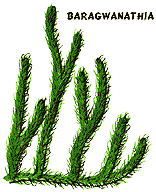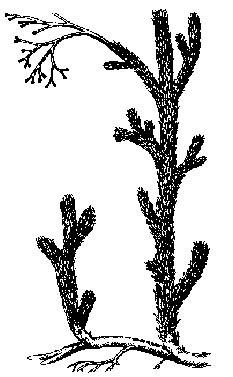Drepanophycales
Ancestral Lycophytes

Baragwanathia, one of the earliest known Land Plants,
from the Late Silurian or Early Devonian of Victoria, Australia
The Asteroxylales were originally included under the Protolepidodendrales, but they are a much more primitive lineage and have been given their own taxon (of ordinal rank). They stand midway between the Zosterophyllopsida and the more developed lycopsids. During the mid-Devonian this lineage split into two: the extant Lycopodium and the Protolepidodendrale - Selaginella
- Lepidodendralean lineage

drawing of Asteroxylon from The Fossil Book - Fenton & Fenton, 1958, Doubleday & Co., p.283 - new edition The Fossil Book : A Record of Prehistoric Life by Pat Vickers Rich (Editor), Thomas Hewitt Rich, Mildred Adams Fenton, Patricia V. Rich, Carroll Lane Fenton
The most primitive member of this group, Asteroxylon (Pragian to Emsian of Euramerica, family Asteroxylaceae) attained a height of 0.5 meters and, like most early land plants, consisted of erect branches originating from a horizontal rhizome. The branches were covered with "enations" (organs that appear to be leaves but lack vascular tissue). Asteroxylon could be seen as an intermediate in the evolution of true leaves in the Lycopsida.
True leaves are found in Baragwanathia and Drepanophycus, which represent the family Drepanophycaceae.
Baragwanathia longifolia is an Australian lycophyte. Its fossil imprints have been found in Yea, Victoria and other localities. This plant has been controversial for some time because of its supposed age as Ludlovian (late Silurian), corresponding in age with Cooksonia, a very much more primitive ancestral vascular plant. This dating is based on graptolites found associated with Baragwanathia. It has been suggested that the Baragwanathia represents a Gondwanan flora which was much more advanced than the contemporary northern hemisphere flora.
An alternative explanation is that the graptolite dating is wrong. Baragwanathia is very similar to Drepanophycus (below left) from the early and middle Devonian of the northern hemisphere. Since it is unlikely that a spore-reproducing plant from one continent would not spread to or exert any influence on the landscape and flora of another continent for many millions of years, a later age for Baragwanathia (probably Early Devonian) may be more plausible.
 |
Drepanophycus (Lochkovian-Frasnian) was a larger plant, the stems of which are up to 4 cm in diameter, bearing stout thorn-like to curved leaves with vascular tissue. The sporangia are kidney-shaped. Drepanophycus may have attained heights of several meters.
Image courtesy of the University of California Museum of Paleontology web site
Copyright The Museum of Paleontology of The University of California at Berkeley and the Regents of the University of California.
This image from The Clade Lycopsida slightly modified |
Links
Asteroxylon - from the Biota of Early Terrestrial Ecosystems: The Rhynie Chert - best on the web
The Clade Lycopsida
page uploaded on Kheper site 11 November 1999, on this site 31 March 2002,
last modified 2 May
checked ATW050811
unless otherwise indicated, content
Creative Commons Attribution M. Alan Kazlev
this material may be freely used as long as attribution is given


